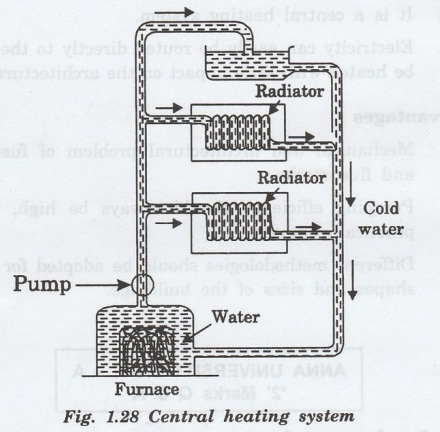Physics For Civil Engineering: Unit I: Thermal Application
Central Heating
Definition, Working Principle, Construction, Advantages, Disadvantages
A central heating system provides warmth to the whole interior of a building or portion of a building from one point to multiple rooms.
CENTRAL HEATING
Definition
A
central heating system provides warmth to the whole interior of a building or
portion of a building from one point to multiple rooms.
In cold countries the temperature in
winter falls to 0°C and even goes to below that value. The rooms of the
building are kept warm by a central heating system based on the principle of
convection.
Principle
The heat is distributed throughout the
building, typically by forced-air through ductwork, water circulating through
pipes, or steam fed through pipes.
The most common method of heat generation
involves the combustion of fossil fuel in a furnace or boiler.
Construction
The circulating hot water can be used
for central heating.
The components of a central heating
system using water-circulation is shown in fig. 1.28.
• A gas supply lines, oil tanks and
supply lines or distinct heating supply lines.
• A boiler (or a heat exchanger for
heating) which heats 9.1) water in the
system.
• Pump to circulate the water in the
closed system.
• Radiators which are wall-mounted
panels through which the heated water passes in order to release heat into rooms.

Working
• Water is heated by the
boiler.
• Hot water from the
boiler rises up and passes through the radiators of different rooms with
• Radiators
get heated and radiate heat to the room.
• Hot
water also reaches the cold water tank at the top of the building.
• Convection
currents are set up and the building is kept warm continuously at a constant
temperature.
• The
circulating water systems follow a closed loop (i.e the same water is heated
and then reheated).
Advantages
1. It is a low cost system.
2. It does not require high electrical
power.
3. It is a central heating system.
4. Electricity can easily be routed
directly to the space to be heated with little impact on the architectural
design.
Disadvantages
1. Mechanical and architectural problem
of fuel storage and flue stacks.
2. Pumping efficiency should always be
high, which is practically impossible.
3. Different methodologies should be
adopted for different shapes and sizes of the buildings.
Physics For Civil Engineering: Unit I: Thermal Application : Tag: : Definition, Working Principle, Construction, Advantages, Disadvantages - Central Heating
Related Topics
Related Subjects
Physics for Civil Engineering
PH3201 2021 Regulation | 2nd Semester Civil Dept 2021 Regulation
